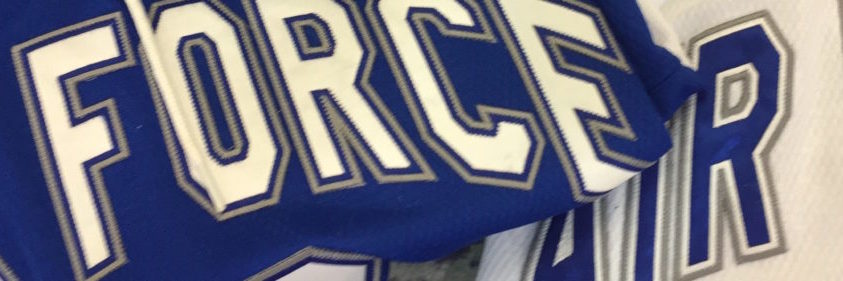Something has to give this weekend at Cadet Arena.
Yes, this could be the weekend Air Force puts together its first back-to-back victories of the season. The Falcons have been stellar on Fridays (4-2) but Saturdays (0-5-1) have been a struggle.
The real intrigue of the series vs. Canisius, one of Atlantic Hockey’s early front-runners, might well be how will one crucial element of the game with in the games play out. That element is special teams.
The Golden Griffins (8-6-1, 5-3-0 AHA) bring the conference’s best power play to the Academy. They have 14 power-play goals in just eight games, an average of nearly two per game. That’s almost half of their AHA-leading offensive output of four goals per game.
Clearly, the Falcons have their work cut out for them.
But not so fast. Air Force’s penalty kill is on a heater of its own in conference play. The Falcons have killed off 32 of 37 penalties in their eight AHA games and lead the league with an 86.5 percent success rate. More impressive, Air Force has not allowed a PPG in its past 22 kills, and it’s killed 31 of its past 34 (92 percent).
How are the Falcons doing it? What do they have to do to keep it rolling?
The will to
To hear PK maestro Joe Doyle, one of Air Force’s associate head coaches, tell it, the success is not that complicated.
“Obviously it starts with the type of players we have,” said Doyle, who has refined a system that former director of hockey operations Steve Miller brought in. “The way we play at 5-on-5 – that rugged, determined type of play lends itself to killing penalties as much as anything.
“Guys are willing to eat a puck on a block, dig in more on a face-off, win 50-50 battles to get a clear. That’s the makeup of this team – selfless and determined.”

Blocking shots is standard fare for Air Force. Photo courtesy of Paat Kelly and Air Force Athletics
Not to be forgotten is goaltender Alex Schilling. As the saying goes, the goalie has to be your best penalty killer.
“We want to help him out by blocking shots,” defenseman Luke Robinson said. “That’s an area we have banded together on.
“It means something here to block a shot. We know we have to be resilient, have guys’ backs, stick up for our teammates – that’s our mentality. What makes this group so special is we all have to go through the same things at the Academy. There are some hard experiences. You have that chemistry already.
“You rely so much on your teammates to get through the day-to-day – everyone helps each other – that it plays over to hockey. I’ve never had that on other teams.”
Getting to know you
The second reason the PK is trending upward is due to the one thing that head coach Frank Serratore loves to remind us is the only thing you can’t buy at Wal-Mart – experience.
“Early in the season I could count on one hand the amount of penalty killers we used who had killed penalties for us before,” Doyle said. “The reality is you need four to five well-trained D and six to eight forwards. We graduated six guys who were are our first killers over the boards.”
Nowhere was that more evident than more than on defense, where the graduations of stalwarts Jake Levin, Alex Mehnert and Zach Mirageas was felt.
“Those three were super hard to replace,” Doyle said. “Brandon Koch had some experience. The rest of this group is young, but they’re on the edge of their seats absorbing information and trying to improve. And we’ve seen across the board improvement from our entire locker room.”
The repetitions come in various forms, and both Robinson and fellow defenseman Luke Rowe said that has sped up what can be a lengthy process.
“Coach Doyle does a great show with our pre-scouts, showing us what specifically teams like to do,” Robinson said.
No time was that more apparent than after a four-game series vs. Sacred Heart in which the guests went 0-for-21 on their power play.
“We were so well prepared,” Rowe said. “We knew everything Sacred Heart was going to do on their power play, and we knew how to handle it. ”
Video is one component, but the rigor of on-ice repetition is another. That helps the process of processing, something that hopefully translates to game speed.
“We will do skeleton drills, talk-through drills, who needs to be where depending upon where the puck is,” Robinson said. “We need to identify what threats are out there.”
The carryover
The familiarity that repetition breeds also helps in other tangible ways.
“We want to eliminate odd-man rushes,” Robinson said. “Our centers and D are working better to break out pucks.”
And it offers hope for areas the Falcons continue to try to improve, mainly offense, which has accounted for just 19 goals in eight AHA games (2.38) and a power play hitting at 12.1 percent.
“There are a few 5-on-3 power plays we didn’t score on we’d like to have back,” Robinson added. “The power play could make a big difference for us because offense is general is something we need to work on.”
So far, however, one of the triggers for the Falcons is the penalty kill.
“If you have a penalty kill when the chips are down, when you see guys working so hard, giving up their bodies to block shots and do whatever they can to get the puck out of the zone, it’s inspiring,” Rowe said. “So everyone wants to emulate that and do their best to make sure their effort wasn’t in vain.”
©First Line Editorial 2021





